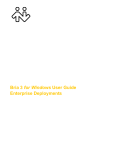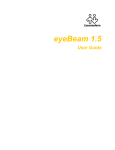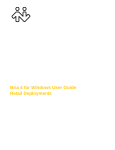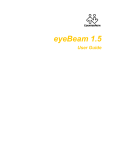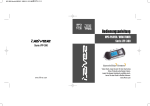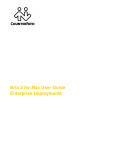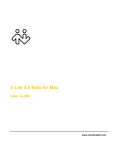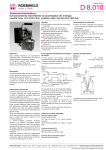Download X-Lite 4 for Mac User Guide
Transcript
X-Lite 4 for Mac User Guide CounterPath Corporation CounterPath Corporation Suite 300, One Bentall Centre 505 Burrard Street, Box 95 Vancouver, BC V7X 1M3 Tel: 604.320.3344 [email protected] www.counterpath.com © August 2010 CounterPath Corporation. All rights reserved. This document contains information proprietary to CounterPath Corporation, and shall not be used for engineering, design, procurement, or manufacture, in whole or in part, without the consent of CounterPath Corporation. The content of this publication is intended to demonstrate typical uses and capabilities of the CounterPath X-Lite 4 for Mac softphone application from CounterPath Corporation. Users of this material must determine for themselves whether the information contained herein applies to a particular IP-based networking system. CounterPath makes no warranty regarding the content of this document, including—but not limited to—implied warranties of fitness for any particular purpose. In no case will CounterPath or persons involved in the production of this documented material be liable for any incidental, indirect or otherwise consequential damage or loss that may result after the use of this publication. CounterPath and the logo are trademarks of CounterPath Corporation. Mac, Mac OS, QuickTime and iSight are registered trademarks of Apple Inc., registered in the U.S. and other countries This manual corresponds to X-Lite 4 for Mac version 4.0. Revision 1 2 Contents Introduction...................................................................................................................................1 Installation and Setup....................................................................................................................3 Getting Ready .........................................................................................................................3 Configuring X-Lite 4 ..............................................................................................................4 Troubleshooting ......................................................................................................................5 Checking for X-Lite 4 Updates...............................................................................................5 Using X-Lite 4 ..............................................................................................................................7 The Onscreen Softphone.........................................................................................................7 Placing a Call ..........................................................................................................................9 Handling an Incoming Call.....................................................................................................11 Handling an Established Call..................................................................................................12 Handling Video Calls..............................................................................................................13 Voicemail................................................................................................................................15 Instant Messaging ...................................................................................................................16 Using the Resources......................................................................................................................17 Contacts Tab ...........................................................................................................................17 History Tab .............................................................................................................................20 Sharing Online Status .............................................................................................................21 Configuring X-Lite 4 ....................................................................................................................25 Configuring your Account ......................................................................................................25 General Preferences ................................................................................................................34 A Troubleshooting ........................................................................................................................43 B Dial Plan....................................................................................................................................47 C Location of Data Files ...............................................................................................................52 D Glossary ....................................................................................................................................53 i CounterPath Corporation ii 1 Introduction Standard Telephone Features The CounterPath X-Lite 4 for Mac softphone has all standard telephone features, including: • • • • Call display and Message Waiting Indicator (MWI). Speakerphone and Mute. Redial, Hold. Call history – list of received, missed, and dialed calls. Enhanced Features and Functions X-Lite 4 also supports the following features and functions: • • • • • • Video IM and presence using the SIMPLE protocol. Managed contact list. Automatic detection and configuration of audio devices. Acoustic echo cancellation, automatic gain control, voice activity detection. Support for the following audio codecs: DVI4, DVI4 Wideband, G.711aLaw, G.711uLaw, GSM, iLBC, L16 PCM Wideband, Speex, Speex FEC, Speex Wideband, Speex Wideband FEC. • Support for the following video codecs: H.263, H.263+ 1998. • Automatic selection of the best codec based on the other party’s capability, the available bandwidth, and network conditions. X-Lite 4 switches the codec within a call in response to changing network conditions. Compliance to 3261 SIP standard. STUN and ICE NAT traversal. Support for DTMF (RFC 2833, inband DTMF or SIP INFO messages). • • • 1 CounterPath Corporation 2 2 Installation and Setup 2.1 Getting Ready Account Information After choosing a VoIP service provider, you will need the following information: • • • • User name and password Authorization Name (if applicable) Domain Firewall traversal and other network information; see “Configuring X-Lite 4” on page 25. System Requirements • Operating System: Mac OS 10.5 or above operating system software. • Connection: IP network connection (broadband, LAN, wireless) Multimedia Device Requirements X-Lite 4 requires both speakers and a microphone to make calls. Any of the following configurations are acceptable: • • • • • External speakers and microphone Built-in speakers and microphone Dual-jack multimedia headset USB multimedia headset USB phone. X-Lite 4 is optimized to work with Apple iSight camera. 3 CounterPath Corporation 2.2 Configuring X-Lite 4 Setting up your Account After obtaining SIP account information from your VoIP service provider, you can set up your X-Lite 4 account. 1. From the menu, choose X-Lite 4 Beta > Preferences. The Application - Preferences window appears. 2. Click on Accounts and complete the User Details area with the information obtained from your VoIP service provider. 3. Complete the remaining tabs as specified by your service provider or to suit your setup. Settings that you may need to change immediately include: • General tab, Domain Proxy area. • Topology tab, if your computer is on a network and/or behind a firewall. For more information, see “Configuring X-Lite 4” on page 25. 4. When done, click OK; the account is enabled and registered; check the account list to make sure the account registers successfully. Setting up for Voicemail Your VoIP service provider may offer voicemail. If it does, then you can set up some voicemail features in XLite 4. See page 27. 4 X-Lite 4 for Mac User Guide Setting up a Contact List Typically, you will want to create contacts in order to easily make calls and send IMs. See page 17. 2.3 Troubleshooting X-Lite 4 includes tools for helping you troubleshoot problems. From the menu, choose Help > Troubleshooting. • • • • • Audio tab: While you are on a phone call, you can test the quality of the audio. Note that to perform a valid test, you should be on an established call (not a call attempt). Video tab: You can verify that your camera is working. Network tab: You can verify that you are successfully connected to the network. Devices tab: You can verify that your microphone and speakers are working and can set the volume to a comfortable level without having to actually place a phone call. Diagnostics tab: If none of the other tabs help you solve your problem. 2.4 Checking for X-Lite 4 Updates To check for updates to X-Lite 4, choose Help > Check for updates. The Auto Update window appears. • • If a new version of the software is available, you can download it from this window. If no newer version is available, this window informs you that your version is up to date. 5 CounterPath Corporation 6 3 Using X-Lite 4 3.1 The Onscreen Softphone Minimize to dock Close window Open/close video window Call entry field See page 9. Show/hide dial pad Hide each resources tab The Call button Resources. See page 17 Resize softphone Show/hide resources tabs You can still receive calls when X-Lite 4 is hidden or minimized. 7 CounterPath Corporation The X-Lite 4 Menu The menu contains the following items that are specific to X-Lite 4: • • • • • X-Lite 4 > Preferences. This menu item lets you configure X-Lite to work with your VoIP service and lets you change the way you work with X-Lite 4. See page 25. View. Change how X-Lite 4 looks and show and hide specific modules. Contacts. Lets you work with contacts. Everything in this menu can also be performed directly in the contact list. Action. Lists the actions that you can perform, depending on the current “state” of X-Lite 4. For example, if a contact is selected, it lists all the actions that can be performed on that contact. Help. Provides access to various service-related features. See page 43. Receiving an Online Status Request When you start X-Lite 4, one of the first things you may see (if availability is enabled) is an Online Status Request dialog. 8 X-Lite 4 for Mac User Guide 3.2 Placing a Call You can contact someone using: • • A softphone address (for example, [email protected]) A traditional phone number, if supported by your VoIP service provider. You can place one more call when another call is already in progress. Click to place the call Call entry field Auto complete suggestions Place the call. See the table on the next page. The outgoing call opens in its own call panel, below any other existing call panels. You will hear a ringing tone while X-Lite 4 attempts to make a connection. How Keying From the... Dialpad or computer keyboard Description 1. Enter the number or address in the call entry field using the dialpad or the computer keyboard. If entering a softphone address, you can enter the entire address ([email protected]) or just the name (kperera). As you type, a suggestion for completing the entry may appear. Choose the suggestion or keep typing. 2. Click the Call button or press Enter. 9 CounterPath Corporation How From the... Description Drag-and-drop contact or Contacts or History tab previous call Drag an entry from the Contacts or History tab. (If the tab contains lots of contacts, first search or filter the list.) Control-click a contact or Contacts or History tab previous call (If the tab contains lots of entries, first search or filter the list.) Redial Redial button Control-click an entry from the Contacts or History tab and choose Call. • When the call entry field is empty, click the Call button. • Or click the arrow in the call entry field and select a recent call. An audio call is placed. Dialing Dialpad 1. If the dialpad is not visible, click the Show/Hide dialpad button. 2. Click the numbers on the dialpad to enter the phone number. 3. Click the Call button or press Enter. Placing another Call To place a new call (without hanging up on the current call), simply place the call in the normal way. A second call panel opens below the current call. The first call is automatically put on hold. Switch between the different calls by clicking Resume on the desired call panel. That call becomes the active call and all other calls are on hold. Existing call New outgoing call Ending a Call Click the red End call button on the Call panel (the call can be active or on hold). The call panel closes after a few seconds. 10 X-Lite 4 for Mac User Guide 3.3 Handling an Incoming Call X-Lite 4 must be running to answer incoming calls. (If X-Lite 4 is not running, incoming calls may be directed to voicemail; check with your VoIP service provider.) As soon as an incoming call is received, a call panel appears, showing information about the call. The name and phone number of the person calling you is displayed. In addition, the Call Alert box appears, even if X-Lite 4 is minimized. Action Answer From the... Call panel or Call Alert box Description Click Answer. If you are on another call, that first call is automatically put on hold. You are now talking to the new caller. Decline Call panel or Call Alert box Click Decline. There will be a busy signal. The call may be directed to voicemail (if you have this service). Video Call panel or Alert box The caller wants to include video. Click to answer a video call and start sending your video immediately. Audio Alert box The caller wants to include video. Click to answer without video; if you want (and if you have a camera), you will be able to add video later. 11 CounterPath Corporation 3.4 Handling an Established Call While the call is in progress you can: • • Control the audio: use the speakerphone, mute the call, control volume. Put the call on hold. Place another call (current call is automatically put on hold). See page 10 Speakerphone (this button is enabled if your computer has a speakerphone) Open or close the video window. If you close it, X-Lite 4 stops sending your video to the other party Show/hide dialpad Volume controls Mute Send an IM to this person (this button appears only if the user has an IM address). 12 X-Lite 4 for Mac User Guide 3.5 Handling Video Calls Placing a Video Call Click the down arrow and choose Video call Call entry field If you mostly make video calls, you can Option-click this down arrow to reveal the “Set Video Call as default action” menu item. How Keying From the... Dialpad or computer keyboard Description 1. Enter the number or address in the call entry field using the dialpad or the computer keyboard. If entering a softphone address, you can enter the entire address ([email protected]) or just the name (kperera). As you type, a suggestion for completing the entry may appear. Choose the suggestion or keep typing. 2. Click the arrow beside the Call button and choose Video Call. Control-click a contact or Contacts or History tab previous call Control-click an entry from the Contacts or History tab and choose Video Call. (If the tab contains lots of entries, first search or filter the list.) Dialing Dialpad 1. If the dialpad is not visible, click the Show/Hide dialpad button. 2. Click the numbers on the dialpad to enter the phone number. 3. Click the arrow beside the Call button and choose Video Call. 13 CounterPath Corporation Adding Video If you have a camera, you can click Start Video to add video to an existing call. When you add video, the other party may (or may not) start sending their video to you. Other Party Adds Video If the other party starts their video, the video panel automatically opens and the video is played. You can start sending your own video, if desired (and assuming you have a camera) by clicking Start Video. Pausing and Resuming Video Click Stop Video or close the video window to pause sending your video. Click Start Video to resume sending your video; the video window will open. Show/hide video window Start and stop your video 14 X-Lite 4 for Mac User Guide 3.6 Voicemail If your service includes voicemail and you have set up voicemail options (page 27), then when you have voicemail messages, a number appears beside the voicemail icon at the top of the phone. You can click the icon to automatically connect to voicemail and listen to your messages. Voicemail icon 15 CounterPath Corporation 3.7 Instant Messaging Instant messages are made using softphone addresses. Therefore, you can send or receive an instant message (IM) to: • • • Any contact who has a softphone address. Any party who phoned you from a softphone address. Any party whom you phoned using a softphone address. Sending an IM 1. There are several ways to select the person to send an IM to. From the Contacts tab An active phone call Control-click on the contact and choose Send IM. The contact must have a softphone address. The person in the active phone call. Click call. on the call panel for this phone The Instant Message window appears. 2. Type the message. Include emoticons and formatting, as desired. To insert a return in the message, press Ctrl+Enter. (You can control the behavior of Enter and of Ctrl+Enter; see page 34) 3. Press Enter. Click to edit the contact information Message input area Receiving an IM When an IM is received, the IM window pops up. 16 4 Using the Resources 4.1 Contacts Tab Add a Contact Filter and sort options Search field The availability of others. See page 21. The Contacts tab displays your contacts and lets you specify multiple contact methods for them, including: • • Softphone address Home phone number, business phone number, mobile phone number You can identify one of these contacts as the primary contact method. When you double-click a contact, the action associated with that method is performed: typically either phone or IM. Contacts are typically organized into groups. X-Lite 4 includes built-in groups: “Family”, “Friends” and “Work”. You can add more groups, as desired. Managing Contacts and Groups Adding a Contact Click table. , or control-click a group and choose Add Contact to Group. The Contact dialog appears. See the 17 CounterPath Corporation Double-click to set an avatar Click to add another phone number field Delete this contact Click to change the type of phone number: “Softphone”, “Home”, “Work” and so on Delete this phone number Table 1: Contact Fields Field Description Contact name Only the “Display as” name is required. This is the name that will appear in the call panel and the Call Alert when this person phones you. Group Click to show the list of groups and check each group to add this contact to. See presence This box becomes enabled only if you have entered a softphone address. Intro Message This button becomes enabled only if you have entered a softphone address. Softphone You must enter at least one contact method. If the default contact method (Softphone) is not correct, click the arrow and change it. Enter as many contact methods as you want. Softphone entries and e-mail entries must have the format <name>@<domain>. Adding a Contact using an Existing Address You can add a contact by capturing existing information. On the History tab, select an entry that is not a contact. Control-click and choose Add as Contact. The Contact dialog appears. Complete the dialog as desired and press OK. If the contact method is Softphone, an online status request is sent to this person. See “Sharing Availability” on page 21. Changing Contact Information To change the information for a contact, control-click the contact and choose Edit Profile. The Contact dialog appears (see page 17). 18 X-Lite 4 for Mac User Guide Moving or Deleting a Contact • • To drag one or more contacts to a different group, select them and drag to the title bar of the new group. To delete one or more contacts, select them, control-click, and choose Delete or Delete Selected Items. The contacts are removed from this group. If a contact belongs to several groups, it is removed from all groups. Adding, Deleting or Renaming Groups Select any group, control-click, and choose the appropriate menu item. Using Contacts Phone the person Control-click and choose Call, then click the desired number. Send an IM Control-click and choose Send IM. See page 16. You can watch the contact’s availability, if the contact has a softphone address See Table 2 on page 23 for the meaning of the availability icons. See “Sharing Online Status” on page 21 for information on obtaining availability information. Contact Flyout Double-click on a contact to show the Contact flyout. This flyout shows all the contact methods set up for the contact. You can click a contact method to perform its action. 19 CounterPath Corporation 4.2 History Tab Filter list Incoming missed call Outgoing call, either attempted or established Incoming call that was answered Managing the Lists of Calls You can control-click on an entry in a list to: • • • • Delete the call. Delete all entries in this list. Edit the profile if the entry is a contact. Add as contact. The Contact dialog appears. For more information on this dialog, see “Adding a Contact using an Existing Address” on page 18. Phoning from History You can control-click on an entry to place a call to this person, using the contact method that was used for this call. 20 X-Lite 4 for Mac User Guide 4.3 Sharing Online Status You can publish your online status to contacts who have softphone address, and you can set up X-Lite 4 to view the online status of other contacts. Typical online statuses are available, on the phone, busy, and so on. Availability of other people Your availability This person has no icon because you are not subscribing to his availability Sharing Availability Watching Others’ Availability When you create a contact by entering details in the Contact, the contact is automatically set up so that you share availability. As soon as the person is set up in this way in your contact list, X-Lite 4 sends them a notification request. The request asks that you be able to see that person’s availability. If the person allows this request, then the icon beside their name (in your Contacts) becomes color coded, so you can determine their availability. Allowing Other Parties to See your Availability (Publishing your Availability) Continuing from above, when the other person allows the notification request, your name is added to their contact list. As soon as you are added to their list, a request is sent back to you requesting that they be able to see you. X-Lite 4 accepts this request automatically, and the other person can now see your availability. 21 CounterPath Corporation Receiving an Online Status Request When someone who is not one of your contacts has you as a contact on their end, you receive an Online Status Request. The request appears to you as an Online Status Request. You must respond to the request: • • Allow the request and create a new contact using this address. This option is selected for you if you do not currently have a contact with this SIP address. Allow the request and update the contact to allow the person to see your presence. This option is selected for you if you already have a contact with this SIP address but you were not previously sharing presence with this person. Button Result Ignore The other person will not be able to see your availability. The Online Status Request may appear again in this session or a future session Allow The other person will be: • Able to see your availability. • Added to your contacts. Because you allow the request, you will no longer be bothered by requests from this person. In addition, this same request will automatically be sent from your X-Lite 4 to the other person, so that you can see their availability. 22 X-Lite 4 for Mac User Guide Setting your Online Status Changing your Status Click the down arrow beside the availability indicator on X-Lite 4, and select the desired availability. See Table 2, below. When your availability changes, the new availability is sent to your contacts. Table 2: Availability Indicators Indicator Available Meaning for your Availability Either: Meaning for Others’ Availability You can contact this person. • You have set your availability to this status. • X-Lite 4 has determined that you are logged on but not on the phone or idle. When you have this availability, X-Lite 4 will automatically detect when you are idle or on the phone, and change the availability to match. Busy You have set your availability to this status. X-Lite 4 will never You can contact this person. automatically switch you out of this status; you must switch yourself. Away You have set your availability to this status. X-Lite 4 will never You can contact this person. automatically switch you out of this status; you must switch yourself. On the phone Either: You can contact this person. • You have set your availability to this status. In this case, XLite 4 will never automatically switch you out of this status; you must switch yourself. • You started a phone call when your status was “Available”. When your call finishes, your status reverts to “Available”. Idle You have not moved or clicked the mouse or pressed a keyboard key for the Idle period. You can contact this person. As soon as you click the mouse or keyboard, your status changes to “Available”. Offline You have set your availability to this status. The other person sees you as offline, even though you are not actually offline. The other person cannot tell the difference between this status and you really being offline. The contact is either not logged on or else is not set up for availability. No icon Not applicable You are not watching the other person’s availability. 23 CounterPath Corporation 24 5 Configuring X-Lite 4 From the menu bar, choose X-Lite 4 > Preferences. The Preferences window appears. • • When configuring X-Lite 4 the first time, click the Accounts tab and set up the account. Then complete other tabs as desired. After the initial setup, display whichever tab you want. 5.1 Configuring your Account To set up an account and configure X-Lite 4 to work with your VoIP service, from the menu bar, choose X-Lite 4 > Preferences > Accounts. The Accounts window appears. Make sure the account is enabled Double-click the account to edit 25 CounterPath Corporation Accounts – General Fields with an asterisk are required Table 3: Accounts – General Field Account name Protocol Use for Description If desired, change the account name to something that is meaningful to you. For example, the name of the VoIP service provider. Read-only. Always specifies SIP. Leave these fields checked. User Details User ID Domain Password Display name Authorization name Provided by your VoIP service provider. This name is displayed in the X-Lite 4 title bar. Other people will see you as this name. May not be required. If it is required, it will be provided by your VoIP service provider. Domain Proxy Register with domain and receive Check this box if you want to register with your VoIP service provider, so that you can receive calls incoming calls. Typically, this field is checked. Send outbound via This field may be left unchecked when, for example, your level of service does not include the ability to receive incoming calls. In that case, turning this field on may cause registration to fail (when you close the Account Properties window), meaning that your X-Lite 4 cannot register with your VoIP service provider. Choose the setting specified by your VoIP service provider: • Domain: If your VoIP service provider requires that traffic be directed to proxies that are discovered via the domain. • Proxy Address: If your VoIP service provider has an outbound proxy address and requires that you provide the address to X-Lite 4. For the address enter a domain name (for example, domain.com) or an IP address (for example, 123.456.789.012). Dial Plan 26 If you are using X-Lite 4 in a test lab, it is possible that neither of these settings is suitable; see page 33 for a third way to direct traffic. See page 47. X-Lite 4 for Mac User Guide Accounts – Voicemail These settings let you set up to interact with your VoIP service provider’s voicemail service. They also let you configure X-Lite 4 to forward calls in several situations, independent of your VoIP service provider’s voicemail service. Your service provider may provide the ability to set up for voicemail outside of X-Lite 4, for example, by phoning a softphone address and following the voice prompts, or by accessing a website. Check with your service provider to determine if another setup mechanism is available. If so, check what the settings are in that setup, and make sure you enter compatible information in X-Lite 4. In particular, if your service provider has a mechanism for call forwarding, find out if you should leave the Forwarding settings on this Voicemail tab blank. Table 4: Accounts – Voicemail Field Check for voicemail Description Set the checkbox in one of these ways: • Check the box if X-Lite 4 must subscribe to be notified when there is a voicemail for you. In other words, to configure for “subscribe for message waiting”. • Clear the checkbox if the service provider’s voicemail server sends notifications without X-Lite 4 subscribing. In other words, to configure for “implicit subscription”. • Clear the checkbox if the service provider does not support voicemail. Check with your VoIP service provider for the correct configuration. Number to dial for checking voicemail Voicemail is offered by your VoIP service provider; it is not part of X-Lite 4. Contact your service provider for information on using voicemail. Optional, but complete this field only if your VoIP service includes voicemail. • Completing this field activates the icon on the softphone. When you click the icon, X-Lite 4 will dial this number. You will be connected to your service provider’s voicemail and can listen to your messages. • If you leave this field empty, then this icon will not work; you will have to manually dial this number in order to connect to voicemail. Enter the number or SIP address provided by your VoIP service provider. 27 CounterPath Corporation Table 4: Accounts – Voicemail Field Number for sending calls to voicemail Description Complete only if your VoIP service includes voicemail. Optional, but you must complete it if you check “Send calls to voicemail if unanswered”. This is the number that incoming calls will be forwarded to if they are unanswered after the specified interval (below). If you leave this field empty, then X-Lite 4 will never forward calls to your service provider’s voicemail. However, most VoIP service providers have their own mechanism for sending unanswered phone calls to voicemail. So leaving this field blank does not mean that forward-to-voicemail does not work. Send calls to voicemail if unanswered Enter the number provided by your VoIP service provider. Complete only if your VoIP service includes voicemail. To send to voicemail after the specified number of seconds. Your service provider may also provide a similar feature that is set up outside of X-Lite 4. If so, make sure you do not enter competing information in X-Lite 4 and in the service provider’s user interface. For example, if you turn off this field, make sure the same feature at your service provider is also turned off. Otherwise, all your calls will continue to be forwarded. 28 X-Lite 4 for Mac User Guide Accounts – Topology Table 5: Accounts – Topology Field Firewall traversal method Description Leave the default. Or if you have problems making phone calls, contact your VoIP service provider for information on which of the other options might work: • Auto detect using ICE: Automatically determine the contact address for signaling traffic. Advertise the local IP, public IP (discovered via STUN, if available), and media relay IP (discovered via TURN, if available), and use these to automatically determine the best route for media traffic during calls. • Discover public IP address: Advertise the public IP address (discovered via STUN) for the contact address for signaling traffic, and for the connection address for media traffic. • Use media relay (TURN): Advertise the public IP address (discovered via STUN) for the contact address for signaling traffic. Advertise the address of a media relay server (discovered via TURN) for the connection address for media traffic. Server address Range of ports • None: Advertise the local IP address only for both signaling and media traffic. • Empty: Discover the address of the firewall traversal server (the STUN or TURN server), if available, using DNS SRV. • Specified: Use the firewall traversal server specified as either an IP address or a fully qualified hostname. The appropriate setting depends on your computer setup: • Checked: If your computer is behind a restrictive firewall that only allows specific port ranges to be used. Enter the range of ports to use for your SIP account. (You must also open those ports on your firewall; refer to applicable firewall documentation for information.) • Unchecked: If your computer is not behind a restrictive firewall. 29 CounterPath Corporation Accounts – Presence Presence allows your contacts to see your online availability and allows you to see the online availability of contacts. See “Sharing Online Status” on page 21. Table 6: Accounts – Presence Field Mode Description Choose the setting specified by your VoIP service provider: • Disabled: Presence is not supported. • Peer-to-Peer. Poll time Enter the value specified by your VoIP service provider. Refresh interval Enter the value specified by your VoIP service provider. 30 X-Lite 4 for Mac User Guide Accounts – Transport Contact your VoIP service provider to identify the types of transport that are supported. Then choose a supported transport: • • • Automatic: X-Lite 4 sets up the transport based on the capabilities of the network and the X-Lite 4 computer. Choose this option if you do not care which transport is used. TCP UDP 31 CounterPath Corporation Accounts – Advanced Table 7: Accounts – Advanced Field Description Register Settings Reregister every Minimum time Maximum time The time interval between X-Lite 4’s attempts to reregister in order to refresh the account registration with the VoIP service provider for this account. A value of zero means not to reregister after the initial registration. This value is placed in the “Expires” header field of the REGISTER message. If the reregistration fails, X-Lite 4 will wait this amount of time, then attempt to reregister. If the second attempt fails, X-Lite 4 will wait twice this time and try again, then four times this time, and so on, until reregistration succeeds. This is the maximum wait time between attempts to reregister. Once this maximum is reached, XLite 4 will wait this time for all subsequent attempts. For example, the min. time is 20 secs, the maximum time is 120 secs. X-Lite 4 will attempt to reregister as follows: • • • • • • • • • Wait 20 secs. Attempt to connect. If fail, wait 40 secs. Attempt to connect. If fail, wait 80 secs. Attempt to connect. If fail, wait 120 secs (the maximum) Attempt to connect. If fail, wait 120 secs, and so on. Timers Enable session timers Default session time A session timer is a mechanism to detect whether a call session is still active from the signaling point of view. When the timer expires, a refresh is sent from one party to the other. The timer is then reset. • Turn on to enable session timer. Enter a value in Default session time. • Turn off to disable session timer; refreshes will never be sent. 32 X-Lite 4 for Mac User Guide Table 7: Accounts – Advanced Field Session timer preference Description This field specifies your preference for which party should send the refresh. The preference is not a guarantee that the refresh will be performed by the specified party. The choices are: • • • • Send SIP keep-alives Use rport Send outgoing request directly to target Use old style hold None: No preference. Local refreshes: Your computer sends. Remote refreshes: The other party sends. UAC refreshes: The user agent client (the party that initiated establishment of the communications) sends. • UAS refreshes: The user agent server (the other party) sends. Typically on, to instruct X-Lite 4 to send SIP keep-alive messages in order to maintain a “pinhole” through your firewall for SIP messaging. Typically on. When checked, requests with a complete URI ([email protected]) go to ABC.com and the “Send outbound via” field on the General tab (page 26) is ignored. If you check this field, make sure you also set “Send outbound via” (on Accounts > Account) to “Domain”. Typically off. This field is intended for test labs and may cause problems in a NAT environment. Check this box only if your VoIP service provider advises you to do so. 33 CounterPath Corporation 5.2 General Preferences From the menu bar, choose X-Lite 4 > Preferences. The Preferences window appears. All the tabs on this window except for “Accounts” are preferences tabs. These tabs let you control the way that you work with XLite 4. Preferences – Application This panel lets you set your preferences for general GUI behavior. 34 X-Lite 4 for Mac User Guide Preferences – Alerts & Sounds This panel lets you control the alert box and lets you assign sounds. Enable Alert Displays You can control whether the Call Alert box is displayed in different situations. You can also control how you are alerted to an incoming IM: either with a small IM Alert box or with the IM window itself. Assigning Sounds You can assign specific sounds to a variety of actions or “events”. 1. Select the Enable sounds check box and select the check boxes for each desired event, or clear the Enable sounds check box to disable all sounds. 2. If enabling sounds, you can change the sound for each event: select the individual event. The value in Sound preference will change. Select the desired sound. You can import sounds; these will be added to the list of sounds you can choose from when assigning a sound to an event. 35 CounterPath Corporation Preferences – Devices X-Lite 4 automatically detects devices at each startup, and selects the most appropriate device for each purpose. If you do not like this selection, you can override it on this panel. If you override a selection, it will apply the next time you start X-Lite 4, unless the device is no longer available, in which case X-Lite 4 will again select the device to use. 36 X-Lite 4 for Mac User Guide Field Description Headset Mode Microphone, Speaker Change these fields only if you want to override the devices that X-Lite 4 automatically selected. In both these fields, select the headset you are using. The headset is the device that is usually used for audio out (the sound you hear) and audio in (recording your voice). The only situation in which the headset is not used is when the Speaker Phone button on the dialpad is pressed. Therefore, unless you will always be using X-Lite 4 in speakerphone mode, you must make a selection here. Select the headset in both the Speaker device field and Microphone device field. Zero-touch device configuration Typically, leave on. When device configuration is on, if you change your audio device, X-Lite 4 will automatically detect the new device and start using it. Test Devices See “Troubleshooting” on page 43. Speakerphone Mode Microphone Change this field only if you want to override the devices that X-Lite 4 automatically selected. Make the appropriate choice: • Select the device that you want to use for audio in (recording your voice) when the Speaker Phone button is pressed. It can be any microphone: it does not have to be the microphone on the device you specified as the speaker device. For example, it can be the microphone on your camera. • Select None if you do not have a speaker phone. The Speaker Phone button on the dialpad is disabled. Speaker Change this field only if you want to override the devices that X-Lite 4 automatically selected. Make the appropriate choice: • Select the device that you want to use for audio out (the sound you hear) when the Speaker Phone button is pressed. Make sure you select a speaker device (not the headset). • Select None if you do not have a speaker phone. The Speaker Phone button on the dialpad is disabled. Other Devices Ring on The device where you want to hear the phone ringing. Change this field only if you want to override the devices that X-Lite 4 automatically selected. Volume The volume of the ringer. Camera This field appears only on versions of X-Lite 4 that include video functionality. Change this field only if you want to override the devices that X-Lite 4 automatically selected. Select the camera model. Resolution Leave at standard, or change the size as follows: • Set it to high if you have a good camera and a computer with a fast CPU. You will know that you have set the size too large if: Your computer slows down (the video is using too much CPU) The video shows black areas or is slow or jerky. • Typically set it to low only in special situations, for example, when using wi-fi in a hotel. You will know that you have set the size too small if the video is fuzzy. This field is identical to the Resolution field in Media Quality > Video Quality. 37 CounterPath Corporation Preferences – Network Select the type of network connection for your computer. The sliders move to show the bitrate that will be used for sending and receiving. These rates are typical rates for the selected configuration. If you know that your computer and network can handle a faster sending speed, click Custom and move the slider. It is recommended that you not change the receiving speed. • • • 38 You will know that you have set the sending speed too high if the remote audio is garbled. You will know that you have set the sending speed too high if: • The remote video shows black areas or is slow or jerky. • The remote audio is garbled. You will know that you have set the sending speed too low if the audio is good but the video is of poor quality (grainy). X-Lite 4 for Mac User Guide Preferences – Codecs Audio Codecs This panel shows all the codecs that are included in X-Lite 4. You can enable or disable codecs as desired. With only one codec enabled, all calls made will use that codec. With more than one codec enabled, X-Lite 4 automatically chooses the best codec based on the other party’s capability, the available bandwidth, and network conditions. You cannot change the properties of any codecs. About Codecs Audio codecs describe the format by which audio streams are compressed for transmission over networks. Codecs can be categorized as either narrowband or wideband: • • Narrowband codecs work with low bandwidth such as a dialup internet connection. These codecs have a sampling rate of 8 kHz. Wideband codecs work with high bandwidths and result in better audio quality. However, they do not work with PSTN. These codecs have a sampling rate of 16 kHz. Supported Codecs Codec Narrowband Wideband Broadvoice-32 3 Broadvoice-32 FEC 3 DVI4 3 3 DVI4 Wideband G.711aLaw * 3 G.711uLaw * 3 GSM 3 iLBC 3 L16 PCM Wideband 3 Speex 3 Speex FEC 3 39 CounterPath Corporation Codec Narrowband Wideband Speex Wideband 3 Speex Wideband FEC 3 * Generally, at least one of these codecs must be enabled in order to place a PSTN (land line) call. Video Codecs Video codecs describe the format by which video streams are compressed for transmission over networks. Some codecs require less bandwidth than others, but may result in lower video quality. You can enable or disable codecs as desired. You may decide to disable a codec even though your VoIP service provider supports it. With only one codec enabled, all calls made will use that particular compression format. With more than one codec enabled, X-Lite 4 automatically chooses the best codec based on the other party’s capability, the available bandwidth, and network conditions. You cannot change the properties of any codecs. Supported Codecs • • 40 H.263 H.263+1998 X-Lite 4 for Mac User Guide Preferences – Media Quality Field Description Audio Quality Reduce echo Reduce background noise Turning this feature on improves sound quality. This feature is typically on. Automatically attempts to remove background noise. Typically on for the speakerphone. Automatic gain control This feature is typically on. Preserve bandwidth When this feature is on, X-Lite 4 stops sending audio when you are not talking. When this feature is off, X-Lite 4 always sends audio, which uses more bandwidth but may result in better call quality. Typically off. However, if you are using a slow (dial-up or ISDN) connection, you may want to turn it on. Video Quality Resolution Leave at standard, or change the size as follows: • Set it to high if you have a good camera and a computer with a fast CPU. You will know that you have set the size too large if: Your computer slows down (the video is using too much CPU) The video shows black areas or is slow or jerky. • Typically set it to low only in special situations, for example, when using wi-fi in a hotel. You will know that you have set the size too small if the video is fuzzy. This field is identical to the Resolution field in Devices > Other Devices. 41 CounterPath Corporation Preferences – Advanced Field DTMF Description You may need to change the DTMF configuration if you cannot interact with interactive voice response systems (auto attendants, voice-activated menus, and so on). Contact your VoIP service provider for the correct setting. RTP This timer controls how calls are disconnected when X-Lite 4 determines that there is a problem with the call and the other party has probably disappeared (assuming that you have not yourself detected the problem and hung up manually). Typically, the timer is enabled. It is recommended that you not disable it. You can change the length of the timer, but do not set it to less than 30 seconds. 42 A Troubleshooting Choose Help > Troubleshooting to display the Troubleshooting window. Testing Audio Quality While you are on a phone call, you can test the quality of the audio. Note that to perform a valid test, you should be on an established call (not a call attempt). 43 CounterPath Corporation Testing Video Quality While you are on a phone call, you can test the quality of the video. Note that to perform a valid test, you should be on an established call (not a call attempt). Testing the Network Connection You can verify that you are successfully connected to the network. 44 X-Lite 4 for Mac User Guide Testing Devices You can verify that your microphone and speakers are working and can set the volume to a comfortable level without having to actually place a phone call. F 45 CounterPath Corporation Diagnostics Only use this panel if instructed to do so by your support representative at your VoIP service provider. To start logging X-Lite 4 activity and send a logging report to customer support: 1. Click Start Logging. The first Diagnostics Logging window appears. 2. Select the problem you are experiencing and click Start Logging. 3. On the second Diagnostics Logging screen, click Finish. Logging will start. 4. Perform the actions you want to capture; for example, attempt to make a phone call. 5. When done, display the first Diagnostics Logging window again and click Send Report. A window opens; select the report and click Open. When the report is successfully sent, a confirmation message appears on the first Diagnostics window. 6. Click Stop Logging. Close the Troubleshooting window. 46 X-Lite 4 for Mac User Guide B Dial Plan You can create a dial plan to modify the call input (what you type, select or drag onto the call entry field) to ensure that the call gets placed successfully. Modifying the input is useful when using numbers from a contact, which may include symbols such as the + symbol. Do You Need to Read this Information? You do not have to read this dial plan information if the default dial plan behavior (below) is acceptable. If you need to modify the input (for example, to prefix the number with “9”), then you must create a dial plan. The Default Dial Plan The default dial plan is: #n\a\a.T;match=1;prestrip=2; where #n is the account prefix; in other words #1 for the first account and so on. X-Lite 4 for Mac supports only one SIP account, so there is no point in including the #1 when you place a call. However, if you are used to eyeBeam, you may be used to entering #1. This dial plan supports that habit: the dialplan removes the #1 and then places the call on the SIP account. Processing of Phone Numbers when a Phone Call is Placed The input is processed as follows: • • Cleanup: Input is cleaned up by removing spaces, dashes, open brackets, and close brackets. Matching: The input is compared to the patterns defined by the dial plan for the account. When a match is found between the input and the pattern, the transformation for this pattern is performed. If no match is found, no transformation is performed. For details on matching see “How the Input Is Processed” on page 50. • • Transformation: The selected transformation is performed. Then the call is placed using the transformed input. 47 CounterPath Corporation B.1 Dial Plan Syntax In X-Lite 4, the dial plan establishes the expected patterns of characters for a telephone number or softphone address, and allows for modification (transformation) of input based on the match to a pattern. The dial plan has the following syntax: pattern[|pattern];match=1;<transformation>=<value>;[match=2; <transformation>=<value>;] Where: • • • Items in [ ] are optional. Pattern: the pattern that will be matched. One or more patterns. Each pattern is separated by a | pipe. The pipe is optional after the last pattern. Each pattern is implicitly numbered, starting from 1. Match; Transformation: A pair that identifies the pattern number to compare with the input, and the transformation to perform on the input when a match is obtained. The transformation is optional (meaning that if there is no transformation for a pattern, then the input that matches this pattern is not transformed). One or more pairs. “match=” is a literal. “n” identifies the pattern. “transformation=” is replaced by a keyword, see below. “value” is replaced by a value. Spaces are allowed only in the <value> items. Example \a\a.T|xxxxxxxxxx;match=1;prestrip=2;match=2;pre=8; where: • • • • 48 \a\a.Tis the first pattern. xxxxxxxxxx;is the second pattern. match=1;prestrip=2;is the first match-transformation pair. match=2;pre=8;is the second match-transformation pair. X-Lite 4 for Mac User Guide Pattern Valid Content The content for a pattern follows the digit map rules of RFC 2705, supplemented by the rules for regular expressions. Where there is an overlap between the digit map and regular expression rules, the digit map rules apply. For this reason, there are some special cases, included in the table below. The following table describes the most common elements. As mentioned, all regular expression elements are supported. Element Origin Description 0 1 2 3 4 5 6 7 8 9 Literals Literal digits, used as is. # * a to z Literal characters, used as is. Special cases: Literals • The literal x character is represented by \x. • The literal t character is represented by \t. x Digit map rules Wildcard for any single digit, 0 to 9. \a Regular expression rules Wildcard for any single alphanumeric character. [digit-digit] Regular expression rules A digit within the specified range. [charactercharacter] Regular expression rules A character within the specified range. [digit1, digit2, digit3] Regular expression rules One of the characters in the collection. . Digit map rules Repeat the last element 0 or more times. For example, xxxx. means repeat the last x 0 or more times, which means this pattern matches three or more digits (not four or more digits)! Use of this element results in a pattern with “minimum requirements”. T Digit map rules A timeout period will take place before automatic dialing starts. The T timer forces X-Lite 4 to wait after a match is made. This timer should always be included in these situations: • Any pattern that uses the . (dot). For example, if the pattern is xxxx. then adding a timer lets you type three or more digits. If there is no timer, then as soon as you type three digits, X-Lite 4 makes the match as soon as you type three digits. • Any dial plan that has two patterns that are similar in elements but different in length. For example, if one pattern is xxx and the other pattern is xxxxxxx, then adding the timer lets you continue typing past three digits, in order to get a match on the second pattern. In this situation, the T timer should be included in the shorter pattern. Timers There are two timers: • • T timer is 4 seconds. The long timer is 20 seconds. These timers are used in input comparison, as described in “How the Input Is Processed” on page 50. 49 CounterPath Corporation Transformation Keywords Keyword Description prestrip Strip the first n characters from the input before placing the call. poststrip Remove n number of characters from the end of the input before placing the call. pre Add the specified account prefix to the input before placing the call. post Attach the specified postfix to the input before placing the call. replace Replaces the input with the specified string before placing the call. Order of Transformations These transformations are always performed in the following order (the order in which the transformations are entered in the dial plan is not significant): prestrip > poststrip > pre > post > replace B.2 How the Input Is Processed Comparing Input to the Dial Plan Patterns The input is compared to each dial plan in turn, starting with the first listed account. The process is slightly different depending on how the call is placed: • If the input was dragged or selected, then the entire input is compared to each dial plan. If a complete match is found, then the associated transformation is performed. If no match is found, no transformation is performed. If you are typing the input, the digits are compared one by one as they are entered. The comparison will result in one of the types of matches described in the table below. • It is possible for the same input to get matched to different dial plans depending on whether the input is entered on the fly or dragged. It is important to keep this in mind when designing dial plan patterns. Results of the Comparison Type of Match Conditions Result if You Press Enter or Dial Result if You Stop Typing Partial match The characters typed so far follow the pattern but No transformation is there are not yet enough characters for a pending performed. or complete match. If you stop typing for the long timer length (20 seconds), then no transformation is performed on the characters typed so far. Pending match • The pattern has no . (dot) but does have the T No transformation is performed. timer. There is a perfect match. • The pattern has a . (dot) and the T timer. The minimum requirements are met. If the T timer expires, the transformation is performed. 50 X-Lite 4 for Mac User Guide Type of Match Conditions Result if You Press Enter or Dial Result if You Stop Typing Complete match • The pattern has no . (dot) and no T timer. The associated transformation is There is a perfect match. • The pattern has a . (dot) but does not have the performed. T timer. The minimum requirements are met. The associated transformation is performed. No match Nothing happens even after the T timer and long timer have expired. The characters typed do not match the patterns for any dial plan. No transformation is performed. B.3 Examples Example 1 \a\a.T|xxxxxxx.T;match=2;pre="9" This simple example shows how to differentiate between a PSTN number and a softphone address, and how to add a “9” dialing prefix only to the PSTN number. Example 2 3xxT|1xxxxxxxxxx|[2-9]xxxxxxxxx|+x.T;match=2;pre="9"; match=3;pre="91";match=4;prestrip=1;pre="9011" 3xxT The first pattern is any three-digit number beginning with 3. No transformation. The assumption is that this is an internal extension. The timer forces X-Lite 4 to wait after detecting a three-digit number beginning with 3, in case you are actually dialing a local call starting with 3. 1xxxxxxxxxx The second pattern is any eleven-digit number beginning with 1. Prefix with 9 and dial as is. The assumption is that this is a long-distance PSTN call within North America (within North America, all long-distance calls start with 1). [2-9]xxxxxxxxx The third pattern is any ten-digit number beginning with a number other than 1. The assumption is that this is a local PSTN call within a ten-digit dialing zone. +x.T; The fourth pattern is a number of any length that begins with +, to indicate an international PSTN call from North America. Delete the +, prefix with 9011 (011 is the number to access an international line from North America). match=2;pre="9"; For the second pattern, prefix 9 to access an outside line. match=3;pre="91"; For the third pattern, prefix 9 and 1 to access an outside line and enter the long-distance code. match=4;prestrip=1;pre="9011" For the fourth pattern, remove the + and prefix 9011 to access an outside line and enter the international code. 51 CounterPath Corporation C Location of Data Files Data files are saved in the standard location for application data. This location is typically: <user directory>/Library/Preferences/CounterPath Corporation/X-Lite 4 52 X-Lite 4 for Mac User Guide D Glossary AEC AGC Broadband Codec Default account Dial plan DTMF IM IP IP address Media MOV MWI Narrowband Presence Proxy PSTN RFC RTP Acoustic echo cancellation. Processing of the audio signal to reduce the echo effect that can arise with a speakerphone or that can arise if the sound from the speakerphone or headphone leaks into the microphone. Automatic gain control. Processing of the audio to adjust the microphone volume level so that the other party does not hear the distortion that might be caused by too high a microphone input or too low volume (due to too low input level). Broad or wide bandwidth. In data transmission, the wider the band, the more data it is possible to transmit in a given time span. A cable, DSL and ADSL connection to the network provide broadband for data transmission. A dialup or ISDN connection typically provide a narrow bandwidth for data transmission. The format by which audio streams are compressed for transmission over networks. The SIP account that will be used when placing an outgoing call, if X-Lite 4 does not determine that another account should be used. X-Lite 4 uses the dial plan to determine the account to use. The rules that X-Lite 4 follows in order to interpret the softphone address or phone number that the user has entered and to modify the number or address, as required, to ensure that the call will be placed successfully. Dual-tone multi frequency. DTMF is the system that is used in interactive voiceresponse menu systems such as the menu system for accessing voicemail messages. The DTMF system allows the user to interact with the menu by pressing keys on a dialpad or keyboard. Instant Messaging. A technology that lets users send text message and files for near instantaneous delivery and display on each others’ computers. Internet Protocol. A data-oriented protocol used for communicating data across a network. IP is the most common protocol used on the internet. A unique number that devices use in order to identify and communicate with each other on a computer network using the IP standard. In a VoIP phone call, the audio portion of the information in a call. Compare to “Signaling”. The Mac QuickTime multimedia container format. MOV files contain audio data in a standard container that allows simultaneous playback. Message Waiting Indicator. An indicator that there is a voicemail message for the owner of an account. In data transmission, the wider the band, the more data it is possible to transmit in a given time span. A cable, DSL and ADSL connection to the network provide broadband for data transmission. A dialup or ISDN connection typically provide a narrow bandwidth for data transmission. An instant messaging feature that allows users to share information about their availability, mood, location and so on. See SIP account. Public Switch Telephone Network. The traditional land-line phone network. Request for Comment. A document that describes an aspect of an internet technology. An RFC may be a proposed, draft or full internet standard. Real-time Transport Protocol. A protocol for delivering the media portion of a data transmission over an IP network. SRTP is another media protocol. 53 CounterPath Corporation Signaling SIMPLE protocol SIP SIP account softphone address SRTP TCP UDP URI URL USB device VAD VoIP WAV 54 In a VoIP phone call, the information in a call that deals with establishing and controlling the connection, and managing the network. The non-signaling portion of the call is the Media. Session Initiation Protocol for Instant Messaging and Presence Leveraging Extensions. The instant messaging (IM) protocol followed by X-Lite 4. It encapsulate the rules for exchanging instant messages. Session Initiation Protocol. The signaling protocol followed by X-Lite 4 for handling phone calls. An account that provides the user the ability to make VoIP phone calls. The account encapsulates the rules and functions the user can access. The address used to connect to a SIP endpoint. In other words, the “phone number” used in a VoIP phone call. For example, sip:[email protected]. Secure Real-time Transport Protocol. A protocol for delivering the media portion of a data transmission over an IP network. SRTP is a secure protocol, which means that the media is encrypted. RTP is another media protocol. Transmission Control Protocol. A transport protocol for delivering data over an IP network. Other transport protocols are TLS and UDP. User Datagram Protocol. A transport protocol for delivering data over an IP network. Another transport protocol is TCP. Uniform Resource Identifier. A name or address that identifies a location on the world wide web. A softphone address is a type of URI. Uniform Resource Locator. A URI that both identifies a name or address and indicates how to locate it. Universal Serial Bus device. A device that follows a specific communications standard. A headset may be a “USB type” of headset. Voice Activity Detection. A technology that detects if audio is a human voice or background noise. X-Lite 4 includes a feature (Preserve bandwidth on the Network panel of the Preferences window) that controls whether audio is transmitted when VAD determines that no one is actually speaking. Voice over Internet Protocol. A variation of IP used for sending voice data over the internet, in other words, used for making phone calls over the internet. Or WAVE. A file format standard for storing audio on PCs.































































